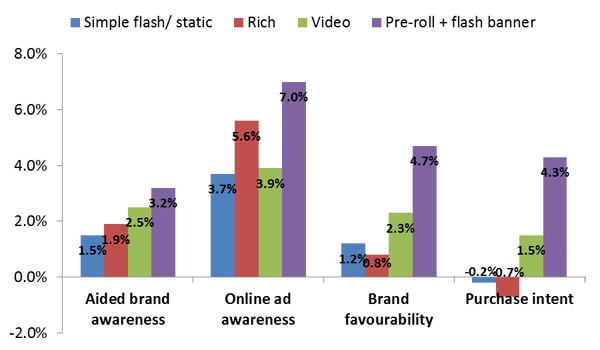Rich display and video ads boost purchase intent
Share
Rich display and video ads not only achieve higher online engagement rates, but are also up to four times more effective at building brand measures than the average campaign, according to Millward Brown.
A study conducted by the researcher on over 80 Australian ad campaigns found that measures of brand awareness, brand favourability and purchase intent were significantly higher among respondents exposed to video and rich display ads than simple flash or static ads.
Comparing the measures between a group exposed to the ads and a control group, the study found that combining pre-roll video ads with flash banner ads yielded the best results, boosting brand favourability by 4.7% and purchase intent by 4.3%.
Video, which includes pre-roll and other video embedded into the page, by itself was less effective, but still managed to boost brand favourability by 2.3% and purchase intent by 1.5%.
 NB: Data shows uplift in measure as a result of one exposure to each ad format.
NB: Data shows uplift in measure as a result of one exposure to each ad format.
The key to getting the most out of high impact advertising, such as video, is combining it with other formats and managing the frequency, says director of Millward Brown’s media and digital solutions, Mark Henning. “Smart integrated planning using multiple formats can yield big benefits,” Henning says, suggesting the use of high-impact placements at a low frequency, complemented by standard banner placements to avoid over-exposure and extend the life of a campaign.
The frequency of exposure to display ads plays an important role, with higher frequency not a positive thing in all cases. Video formats were found to be stronger performers at lower rather than higher frequencies, particularly for brand favourability and purchase intent measures. In fact, over-exposure to high impact formats can drive down attitudes toward a brand, particularly purchase intent.
For standard or flash banner ads, a frequency of five to eight is the most effective range and, given the vast majority of web browsers only glance briefly over banner advertising, brand marks such as logo or message should be present in every frame to maximise effectiveness. If these don’t come across within a few seconds at any point in the ad’s rotation, impressions can be wasted, the study found.
“To maximise effectiveness of online banners, we need to make every frame of the creative work to convey brand and message,” Henning adds.
A constant brand and message presence in the ads showed clear benefits, with awareness, favourability and purchase intent measures more than double for those with 100% logo presence over those with only partial presence. A similar trend was noted for ads with 100% message presence compared to partial message presence.
The days of solely measuring online campaign success on a cost per click or lead-generation basis are fading, Henning says, with these measures indicating engagement with the ad itself rather than its success in improving brand metrics.
“The adoption of tablets, continued growth of mobile, and the convergence of digital and television open a world of interesting new brand interactions, and getting brand building right on these platforms will only become more vital as digital moves closer to the heart of media and creative campaign planning.”
Currently, constant logo and message is not something advertisers are implementing universally, with nearly 40% of the campaigns tested not featuring the brand in every frame and over half without the message present across the creative.














